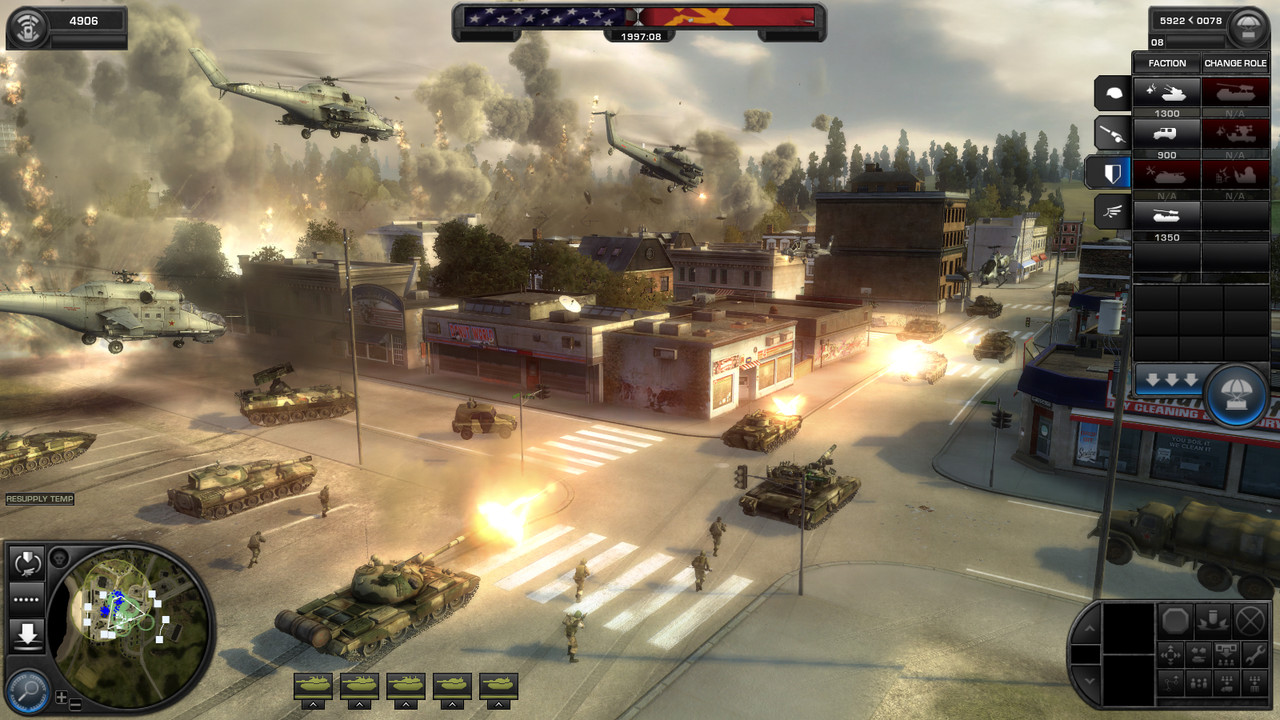INTRODUCTION
This paper will do analysis on World In Conflict, a real-time tactics game from Ubisoft released in 2007, which has received generally excellent reviews (Gamespot 9.5/10, Editor’s Choice), by using 5 lenses in Jesse Schell’s book. World In Conflict depicts an imaginary world-war between USSR and USA in late 1980s.
Gameplay: http://www.youtube.com/watch?v=KCrnJq4O1Uk
ANALYSIS
Lens 6: The Lens of Problem Solving
World In Conflict is widely categorized as RTT (real-time tactics), The “tactics” word implies the matter of problem-solving in this game.
• What problems to solve? The problem in this game is “How to destroy the other side or win the mission in the war with a fixed supply of resources (armory) within a definite length of time”. You should keep to keep your side alive or keep the position from being lost and find ways to move your troops wisely that the enemies can’t destroy yours. For example: Mission 14 (One Last Fight), you only have 45 minutes to complete the objectives “Save Seattle” to take back the position, with only a number of supply units, if you can’t solve in 45 minutes, you lose. This is not easily placing your troops around and the computer will solve all for you, but, you should place them in strategic positions or at suitable times to maximize the gain of your side.
• Hidden problems: There are plenty of extra missions to gain badges aside of main missions. If you can finish extra mission (secondary objectives), you can have more supply units as a reward.
• New problems are generated every main as well as secondary objectives, constituting the whole problem of the game: how to defeat USSR in war.
Lens 21: The Lens of Functional Space
• Spaces in WIC are discrete: all over the world from France, North Europe to USA (Seattle and New York). However, they are connected in a theme: the whole world is in a war, and they are all tactical locations of the war.
• In each map, it is usually divided into some important position that you should care for, they are “positions” to hold or occupy where the war is happening. Other places are usually having no game happenings, or controlled by AI and you don’t have to care about.
• You view the space (game backdrop) via 3D 360-degree third person perspective. Also you can manage the whole war (especially in distributing troops, directing troops and directing tactical weapon) using Radar Map.
Lens 25: The Lens of Goals
• The ultimate goal of WIC is to defeat the opponents, the USSR, in every missions, every levels. Some objectives even don’t mention about defeating the other side, just about improving your side, your armory, but the ultimate goal is still to defeat, to destroy the opponent agent in the game.
• The goal is really clear to gamer.
• The series of goals, as mentioned, is the chain of main objectives combined into missions, and missions combined into the game.
Example: Mission 1 “Invasion!” consists of objectives “Rescue The Infantry”, “Secure The Supply Depot”, etc.
• The goals are related in a meaningful way. Considering Mission 9, Objective 1 Secure Submarine One, then you move to securing submarine Three (2), then you move to hold submarine Three. WIC combines of goals chained by this pattern: Secure – Move on – Reoccupy – Hold.
• The goal is rewarding (badge rewards).
• Goal solutions are decided by users. You control your side continuously to win. If you just watch your side in WIC and don’t do anything, you will lose PC AI and can’t achieve the goal.
Lens 27: The Lens of Skill
• The skill in WIC is mental skill. Certainly because this is a tactical game. You should wisely decide how to buy good armor at different missions, different times. You should watch out the terrain, watch out the balance between you and the opponent side. Sometimes it requires agility to click fast, move fast due to time restrain.
• The skills can be practiced. You play frequently and you realize the best way to combine different type of armors, vehicles, and infantry to form the best troop. You make familiar with the map and reduce time of decision.
• High level of skill is required for Hard mode, where time limit is really strict, and PC side has much more intelligent AI and discernibly stronger than you (faster vehicle movement, more stamina…).
Lens 39: The Lens of Time
• WIC has a good management of gameplay with regards to time. Time for a mission (in medium level) is usually 1 to 2 hours. Some missions are longer, especially those concern with larger map and larger troops with more armory. This gives the players a thrilling experience with large-scale warfare. Minor objectives (occupy vacant position, gather troops) cost less time. The time distribution is really balanced. This reminds that WIC is a real-time tactics game, which should stimulate the real warfare in a reasonable timeframe.
• Time limit in some missions makes the game really exciting, which users should always think of the best way to manage the troops around the map: move and move fast. Mission 5 in WIC really provides you with a thrilling experience of time: calling an atomic bomb and you should evacuate the position in 30 minutes time.
• Time in tactical support calling: for a tactical weapon (that you can just only call and wait for some minutes of time to take it), this really makes the game realistic. In reality, you cannot call and get the bombing plane right after that, but you should wait until they fly to you. Especially, “stronger” tactical weapon takes more time to come, which makes you sense the matter of tradeoff: you should make a good choice when playing.

